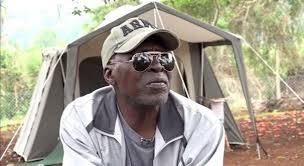TRANSPARENCY: CoST Uganda Commissions 2nd Infrastructure Transparency Index
BY PATRICK JARAMOGI
KAMPALA, Uganda|SHIFTMEDIA| THE GALLANT SOLDIER HAS RESTED! May your soul Rest in Peace.
Major Gen (RTD). Wasswa Kasirye Ggwanga breathed his last early on Tuesday, June 9 2020 after three weeks battling with chronic ailments at Nakasero Hospital In Kampala. Kasirye Gwanga will go down into Books of History for dying on Heroes Day, the same day Edidian Luttamaguzi of Kikandwa, in Semuto was killed on the orders of Gen. Bazilio Okello on June 9th, 1981. For those who don’t recall, it is the reason Uganda celebrates Heroes Day on June 9, to commemorate fallen Luttamaguzi.
As we publish this, the fallen Hero from Mubende district has been transferred from Nakasero Hospital to Bombo UPDF Military Hospital for post mortem and further management according to UPDF sources. The UPDF Deputy Spokesman Lt. Col. Deo Akiiki has confirmed that Kasirye Gwanga will be accorded a full military burial on Friday, June 12 2020 in Maya Village, Busunju Sub County, in Mityana district.
Why was Kasirye Gwanga a Hero?
It was a Saturday afternoon, January 25 1986 when the National Resistance Army (NRA) then captured Uganda’s capital, Kampala. In fact, Uganda is supposed to celebrate the Liberation Day on this day, but just like President Museveni wrote in his Mustard Seed, this was the same day and date that Idi Amin Dada disposed off President Apolo Milton Obote on January 25, 1971, as he attended the Commonwealth Summit in Singapore.
It would then be embarrassing to keep celebrating the Liberation Day that has memories with Idd Amin. In brief, the celebrations were changed to January 26th. But, that is not the story for today.
During one of the interviews, I conducted with Maj. Gen. Kasirye Gwanga at his 200-acre farm (Camp David) in Mukono shortly before he fell sick, he boasted of how Kampala wouldn’t have fallen if it wasn’t for his sharpness.
Kasirye who was under the Command of Pecos Kutesa under the 1st battalion (The black Bomba) was to attack Kampala from Busega roundabout along with the 3rd battalion that was led by Patrick Lumumba.
The 5th Batallion headed by Ahmed Kashillingi came in from Masaka to Kampala through Mpigi, while the 7th battalion attacked Kampala through the Mityana route. The 11th battalion which had the likes of Gen. Kayinda Otafiire attacked Kampala through Hoima road accessing the city through Nansana and Nakulabye routes.
According to Kasirye, the attack on Lubiri was fierce and took a long time. Kasirye is remembered for crawling along the Nakivubo channel (Clock Tower) to Kololo (Golf Course) where he was instrumental in engaging the Cubans who were firing the 120mm artillery at the Kololo Summit View.
Close friends of the fallen General say that Kasirye was good at handling the 120mm artillery. Indeed, his expertise on handling these weapons saw the eventual besiege of the Cubans who were firing the artillery.
There defeat marked the final assault and fall of Kampala City. Kasirye was at this time supported by the 11th Batallion commanded by the late Chefe Ali that moved up Kololo Summit View through Kamwokya. The UNLA forces then commanded by the late Lt. Col. Odwor withdrew.
Education background
Gen. Kasirye Gwanga was born on 1st January 1952, in Mubende District, to a father who was a hunter and farmer. Kasirye Ggwanga learned both skills and is still good at both. He attended Katakala Primary School, then he studied at Kibuli Secondary School for his O-Level education. After finishing Senior 4, he joined the Uganda Army in 1972.
He is married with kids. He left a widow who is based in the US. Two of his children are also based in the US.
Joining the armed struggle
After leaving Kibuli SSS in Senior Four, Kasirye underwent boot camp and initial training, before he was posted to Arua in the West Nile sub-region, as a map reader, serving in that capacity until 1977. In 1978, he was promoted to the position of an artillery officer and the following year, he was promoted to the rank of staff sergeant.
In 1978, the Tanzania People’s Defence Force (TPDF) invaded Uganda. In April they captured Kampala and deposed Idi Amin. Kasirye Ggwanga surrendered and was taken to Tanga, Tanzania, as a prisoner of war number 17341.
In June 1980, president Godfrey Binaisa negotiated the return of the political prisoners to Uganda. They were first housed at Maluku Prison in Mbale District. Later, they were moved to Kirinya Prison, Jinja District. On 7 October 1981, Kasirye Ggwanga was in the first batch to be released.

Three months after Kasirye Ggwanga’s release, the Uganda Freedom Army (UFA) rebels led by Andrew Kayiira attacked the army barracks at Mengo Lubiri in Kampala. The government in power at the time, led by Milton Obote of the Uganda People’s Congress (UPC) mistakenly thought that the recently released prisoners (former Idi Amin soldiers) were involved in the attack. Kasirye Ggwanga was placed on the “wanted list”. He went underground.
His elder brother, Lieutenant James Kasirye, a military pilot then based at Nakasongola Military Air Base was arrested and tortured, then killed when he refused to identify where his brother Kasirye Gwanga was hiding.
To avenge the killing of his brother, Kasirye Ggwanga joined the UFA rebels, then about 650 in number. This group operated in the Mawokota and Mubende areas in Buganda. In 1985, he left UFA and joined Yoweri Museveni’s National Resistance Army, which captured power in January 1986. During the drive to capture Kampala, Kasirye Ggwanga commanded a 120mm artillery unit.
Between 1986 and 2005, he served in several roles including as the LC5 chairman for Mubende District and as the director of stores in the UPDF. On 31 January 2005, he was retired from the UPDF at the rank of brigadier. However, after three months on the outside, he came back to the military and asked to be re-instated. The UPDF commander-in-chief allowed him to rejoin on a renewable contract of five years.
In March 2018, Kasirye Ggwanga was promoted from the rank of Brigadier to that of Major General, in a promotions exercise involving 1,384 men and women of the UPDF. He was also officially retired from the Uganda military, in 2018.








